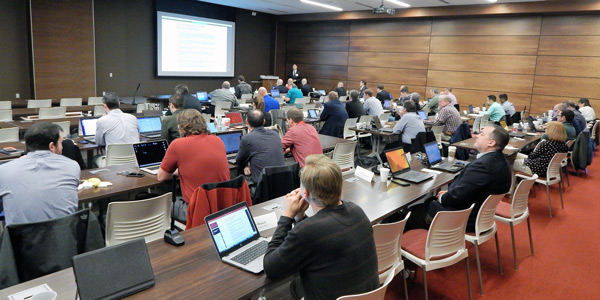By Tom Kleckner
LITTLE ROCK, Ark. — Fresh off setting the wind penetration record for North American RTOs, SPP is setting its sights even higher.

The RTO’s two most recent studies of wind and other variable resources analyzed wind-penetration levels as high as 60% and found that the RTO has the potential to serve 75% of its load with wind, Operations Vice President Bruce Rew told SPP’s Variable Generation Integration Workshop on Wednesday.
But why stop there? Asked how high a penetration level SPP could handle, Casey Cathey, SPP’s manager of operations analysis and support, replied with a smile: “As high as you want.”
That’s a big change, Cathey said, recalling “we were freaking out about 20% in 2009.”

SPP set the record for wind penetration at 4:30 a.m. Feb. 12, topping out at 52.1%, with several hours also registering above 48.5%. (See related story, SPP First RTO to 50% Wind Energy Penetration Level.) The RTO has set seven wind peaks in the last 14 months, the latest coming Feb. 9 when the footprint produced 13,342 MW of wind energy.
“We’ve been studying [wind] at higher load levels than SPP’s minimum [load] at times,” Rew said. “With nukes and hydro, we could have a majority of our load being served by [non-thermal generation] using the existing system we have now.”
32 GW of Wind?
SPP currently has 87,635 MW of generating capacity, with gas (42%) and coal (31%) providing the great bulk of it. Wind accounts for 18% of the capacity (16,124 MW of nameplate generation), with hydro (4%) and nuclear (3%) trailing. An additional 32 GW of wind capacity is in the interconnection queue, along with more than 4 GW of solar.
Cathey said a “good” wind-capacity factor is around 30%, but SPP’s newest wind projects have factors of more than 50%.
“Maybe not all that 32 [GW] will be installed, but we know we’ll have more than 16” GW, he said.
Staff last week shared the results of its latest variable generation study, which looked at requirements to reliably operate at higher wind-penetration levels. Using 45% and 60% scenarios, staff analyzed transient stability, frequency response, seasonal voltage stability, seasonal load-pocket stability and five-minute ramping.
The study assumed 27,419 MW of wind generation would be in service by the end of 2019.
“I don’t that that we will hit 27 [GW] in three years, but when you see a number like this, I think there’s going to be a lot of wind coming in,” SPP’s Jason Tanner said.

“We discovered we needed additional data,” Cathey said, citing the longitude and latitude of every wind farm in the footprint as an example. “We really need a good, robust plan for handling this stuff.”
The transient stability study showed the system could handle 45% and 60% wind penetration for simulated events. But it found the SPP damping ratio criteria of 0.8% — a measure of how quickly oscillations in a system decay after a disturbance — to be very low, and out of line with the 3 to 5% used by much of the industry.
Frequency response was found to be fully compliant with NERC criteria and indicated that new and existing renewable resources can be reliably integrated at higher penetration levels. However, three of the four cases used in the voltage-stability analysis found limitations. A 2021 case at the 60% level was successful in the planning models without operation outages.
Staff determined further analysis is needed in the ramping five-year outlook to focus on the risk of forecast errors.
Recommendations
Based on the study’s results, SPP staff recommended:
- Using an online voltage stability analysis tool to manage voltage fluctuations;
- Having the Transmission Working Group define the requirements for a voltage stability analysis of low-load scenarios;
- Asking the TWG to consider increasing the existing damping ratio (0.8%) in SPP’s voltage disturbance performance requirements;
- Installing transient stability contingency screening and other tools measuring signal changes over time for next-day operational analysis;
- Quantifying the risk of load and renewable forecast deviations;
- Having the TWG assess the cause and impact of modes of inter-area oscillation for machines identified by the SPP study; and
- Using the report’s findings as parameters for future phasor measurement unit siting.
Staff will present the study’s findings and recommendations to SPP’s Board of Directors and Markets and Operations Policy Committee in April.
“We are reliable, we are secure,” Golden Spread Electric Cooperative’s Mike Wise said. “That’s a great distinction to talk about.”

But when is too much wind too much? The Export Pricing Task Force found that SPP’s neighbors share the same problems in working with massive amounts of wind.
“There are things that can be changed in different areas, but there’s not a silver bullet,” Sam Loudenslager, the task force’s staff secretary, told attendees. “We’re not alone in this. There’s a lot of wind around us, and we’re all going to be competing to manage it.”
So far, the task force has focused primarily on educating members and other stakeholders, Loudenslager said. He said the group is planning to provide market and Tariff changes for consideration to the Strategic Planning Committee in April or May.
Staff described several market mechanisms it is pondering to deal with the issue, including adopting coordinated transaction scheduling (CTS), which reduces uneconomic flows across RTO borders by allowing traders to submit “price differential” bids that would clear when the price difference between the regions exceeds a threshold set by the bidder.
NYISO has been using CTS with PJM since November 2014 and began it with ISO-NE in December. PJM and MISO plan to launch CTS later this year. (See “MISO-PJM Coordinated Transaction Scheduling Delayed,” MISO Market Subcommittee Briefs.)
Staff is also evaluating RTO-to-RTO energy transfers similar to the CTS and market-to-market processes, multiday economic commitments, and ramp products, among others, as possible solutions.



